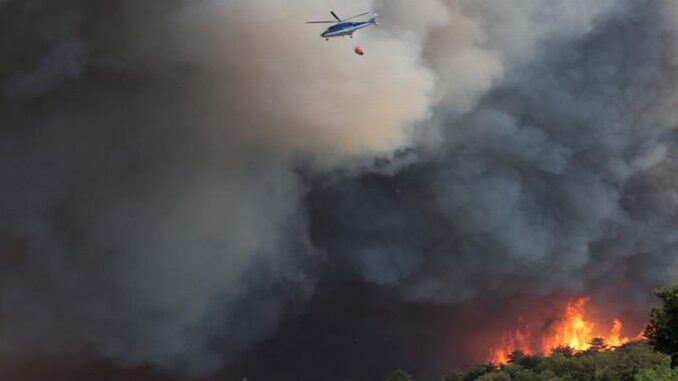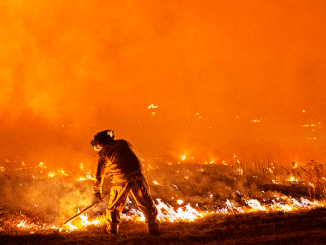
BRUSSELS, Belgium, November 25, 2023 (ENS) – The European Commission has proposed the EU’s first Forest Monitoring Law to plug existing gaps in information about European forests. It is expected to create a comprehensive forest knowledge base so that forest owners and managers can improve their responses to growing pressures on forests and strengthen forest resilience.
Commissioner Virginijus Sinkevičius of Lithuania, who has served as European Commissioner for the Environment, Oceans and Fisheries since 2019, explained the proposed Forest Monitoring Law at a news conference Wednesday in Brussels.
“The framework will have two main pillars,” Sinkevičius said. “The first pillar will be forest data for which the Commission takes the lead, with standardized data based on Earth observation systems like Copernicus. That service will be free of charge for Member States and other users.”
Copernicus is the EU Earth observation program which provides information on the planet from both satellite monitoring and in situ data.

“The second pillar will be forest data collected by the Member States, largely taken from National Forest inventories,” Sinkevičius said. “We’ll ensure comparability by requiring Member States to share their data in a harmonised way. Yet, we are not replacing national systems.”
“We’re building on them to deliver a comprehensive, EU-wide system for the very first time,” he declared.
“Forests are an essential ally in the fight against climate change and biodiversity loss, and crucial for flourishing rural areas and bioeconomy. But Europe’s forests suffer from many pressures, including climate change and unsustainable human activity,” Sinkevičius said.
“Many forests in the EU are not in a good state overall,” the Commission said. “They are suffering from biodiversity loss and are heavily affected by climate change, aggravating and cumulating other destructive pressures such as pests, pollution and disease.”
Climate change leads to long periods of drought and heat that are likely to increase the extent and intensity of future forest fires across the EU. And while climate change takes a mounting toll on the forest industry’s stability and productivity, the demand for forest products and services is growing.
These pressures undermine forest resilience and pose a threat to the capacity of forests to perform their different environmental and socio-economic functions, including their role as natural carbon sinks, the Commission explained in a statement.
Information Gaps and Overlaps
Overall information about the status of forests in the EU is fragmented.
Data on their environmental, social, and economic value, the pressures they face and the ecosystem services they provide are largely heterogeneous and inconsistent, the Commission explains, saying, “The data currently available has gaps and overlaps, and is often provided with significant delay.”
Currently, available information on the state of forests and the use of forest resources and services is scattered and incomplete. Data on EU forests is often outdated and produced using diverging definitions, resulting in knowledge gaps. A comprehensive monitoring system is intended to address those inconsistencies.
Even advanced monitoring systems lack coverage of non-forestry data such as biodiversity and climate. The EU lacks a common system to collect long-term, accurate and comparable forest data. This limits the ability of the 27 Member States, foresters, forest managers and other stakeholders to take informed decisions and act against stressors and threats, including for taking rapid and efficient disaster risk responses.
Systematic EU-wide forest monitoring for climate hazards, risks and damages at high resolution and high frequency is particularly important, to improve risk management, adaptation and post-disaster recovery.

The risks are real and some reliable information is available. The Commission Wednesday issued a report, “Forest Fires in Europe, Middle East and North Africa 2022,” which shows that last year, nearly 900,000 hectares of land was burned in the EU, an area roughly equal to the size of the island of Corsica.
For the third year in a row, unprecedented wildfire events caused large environmental and economic damage in the EU and tragic loss of life.
Fires impacted Natura 2000 sites, the EU’s biodiversity reservoir, accounting for about 43 percent of the total burned area. The total burned land in Natura 2000-protected areas in 2022 was the highest in a decade, according to the report.
While 96 percent of the fires are caused by human actions, they are aggravated by increased fire danger conditions driven by climate change. It is a warning signal of what global warming can bring about in the coming years, as temperatures increase, and droughts become more pronounced in many European countries.
The report also shows that prevention measures play an important role in reducing the frequency and impact of the forest fires, and that updated knowledge is key to ensure it.
Monitoring Law Would Overcome Forest Data Flaws
The proposed law would establish a comprehensive, high-quality monitoring system that ensures standardized or harmonized data and covers all forests and other wooded land. It would build on existing data sets, good practices of Member States and the technological advancement of remote sensing as well the EU capacity to provide these services.
If adopted, the Forest Monitoring Law will create:
- – A system for mapping and localisation of forest units
- – A forest data collection framework, combining standardised data, for which the Commission will take the lead role and provide a cost-effective service from Earth observation (Copernicus), with harmonised data, largely from National Forest Inventories, that is comparable across Europe.
- – A forest data sharing framework – both the Commission and Member States will publish this data, including in the Forest Information System for Europe.
Forests generally act as carbon sinks, absorbing the greenhouse gas carbon dioxide (CO2) and emitting oxygen. But now, the Commission reports, in several key areas across the European Union forests that act as a natural carbon sink are declining.

In certain areas, forests have even become a source of carbon dioxide (CO2) emissions, according to reporting provided by EU Member States under the Land Use, Land Use Change, and Forestry regulation.
Better monitoring will enable action to make forests more resistant to the cross-border threats of pests, droughts and wildfires that are aggravated by climate change, the Commission says.
The Commission would also like to see better monitoring that enables new business models such as carbon farming, and supports compliance with existing EU legislation.
The Commission says that ultimately, the new legislation “will help strengthen the capacity of forests to fulfill their multiple environmental and socio-economic functions, including their role as natural carbon sinks.”
To stay on track, the EU must strengthen the resilience of natural ecosystems, increase their ability to help us adapt to climate change and maintain their productive capacity to ensure lasting food and material security, the Commission says.
“Today’s initiatives and their targets rely on solutions provided by nature as our best ally in the fight against climate change,” the Commission said. “They will help the EU to deliver on climate neutrality by increasing the volume of carbon removed by natural sinks.”
This will also contribute to the EU upholding its international commitments under both the Paris Agreement and the Kunming-Montreal Biodiversity Framework.
Improvements Expected From Forest Monitoring Upgrades
The proposal does not introduce new direct administrative requirements for businesses, forest owners and foresters.
Instead, by ensuring cooperation among Member States, and by encouraging them to set up long-term forest plans, taking into account all the relevant policy dimensions and the multi-functionality of forests, the framework is expected to help create an integrated forest governance.
The framework will bring economic benefits as it will support forest managers to market their ecosystem services, such as carbon removals, under the EU Carbon Removal Certification Framework.
Based on more credible and accessible data, forest managers and forest owners will be able to develop new business opportunities that will provide additional income, while at the same time scaling up carbon farming and contributing to climate mitigation and adaptation. The new law will also support a new market for providers of digital monitoring services, including a high number of SMEs and innovative start-ups.
Finally, the proposal will support the implementation of other key legislation, such as the LULUCF Regulation, Habitats and Birds Directives, Deforestation Regulation, as well as Carbon Removal Certification, and the Nature Restoration Law once adopted by the co-legislators.

From Strasbourg, the EU’s new Climate Commissioner Wopke Hoekstra of The Netherlands, appointed in October to replace Franz Timmerman, commented, “Forests do play a massive role in reaching: one, climate neutrality by 2050; and two, reversing biodiversity loss.”
“You could say that forests are a very important natural carbon sink. They help us reduce the impacts of climate change, for example when we are talking about the topic of cooling down cities. Healthy and resilient forests can also protect us from heavy flooding and reduce the impact of droughts,” Hoekstra said.
“But the unfortunate reality is that Europe’s forests suffer from many different pressures, which are made worse by climate change,” he said, focusing on wildfires.
“It is of course human actions which cause these wildfires, but climate change makes the forests more prone to catching fire in the first place, and the wildfires themselves are actually much more difficult to contain. These are warnings of what global warming can actually bring, as temperatures increase and droughts become more prolonged and more pronounced across the world, but also across our own Union.”
The forest carbon sink is declining in several key areas across the European Union, Hoekstra said, stressing, “That is a trend, ladies and gentlemen, that does need to be reversed.”
As part of its wider work under the EU Forest Strategy, the Commission Wednesday adopted a proposal for an updated EU Forest Governance, which aims to create a renewed, inclusive and inter-disciplinary Expert Group of Member States competent on all forest and forestry matters, reflecting all the environmental, social and economic objectives of the EU Forest Strategy.
The proposal will now be examined by the European Parliament and the Council under the ordinary legislative procedure.
Featured image: When Slovenia requested EU support for fires in the Gorica region on July 20, 2022, the EU coordinated firefighting planes from Romania, helicopters from Austria, Croatia, Slovakia and Serbia, and a Croatian ground firefighting team. July 20, 2022 (Photo courtesy EU Civil Protection and Humanitarian Aid)



